Glasses
| Glasses | |
|---|---|
| Intervention | |
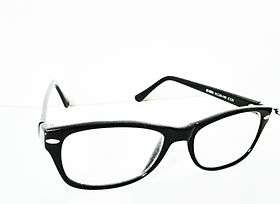 A modern pair of prescription reading glasses |
Glasses, also known as eyeglasses or spectacles, are devices consisting of lenses mounted in a frame that holds them in front of a person's eyes. Glasses are typically used for vision correction. Safety glasses provide eye protection against flying debris or against visible and near-visible light or radiation. Sunglasses allow better vision in bright daylight, and may protect one's eyes against damage from high levels of ultraviolet light. Specialized glasses may be used for viewing specific visual information (such as stereoscopy). Sometimes glasses are worn simply for aesthetic or fashion purposes. The number of Americans who are nearsighted has doubled since the 1970s and almost 3/4 of the US population wears glasses. People are more likely to need glasses the older they get with 93% of people between the age of 65-75 wearing corrective lenses.[1][2]
Types
Glasses come in many types. They can be classified by their primary function, but also appear in combinations such as prescription sunglasses or safety glasses with enhanced magnification.
Corrective
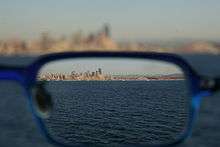
Corrective lenses are used to correct refractive errors by bending the light entering the eye in order to alleviate the effects of conditions such as nearsightedness (myopia), farsightedness (Hypermetropia) or astigmatism. Another common condition in patients over forty years old is presbyopia, which is caused by the eye's crystalline lens losing elasticity, progressively reducing the ability of the lens to accommodate (i.e. to focus on objects close to the eye). Corrective lenses are made to conform to the prescription of an ophthalmologist or optometrist. A lensmeter can be used to verify the specifications of a pair of glasses.
Pinhole glasses are a type of corrective glasses that do not use a lens. Pinhole glasses do not actually refract the light or change focal length. Instead, they create a diffraction limited system, which has an increased depth of field, similar to using a small aperture in photography. This form of correction has many limitations that prevent it from gaining popularity in everyday use.
Corrective eyeglasses can significantly improve the life quality of the wearer. Not only do they enhance the wearer's visual experience, but can also reduce problems that appear such as headaches or squinting.
The most common type of corrective lens is "single vision", which has a uniform refractive index. For people with presbyopia and hyperopia, bifocal and trifocal glasses provide two or three different refractive indexes, respectively, and progressive lenses have a continuous gradient. Reading glasses provide a separate set of glasses for focusing on close-by objects. Adjustable-focus eyeglasses might be used to replace bifocals or trifocals, or might be used to produce cheaper single-vision glasses (since they don't have to be custom-manufactured for every person).
Safety
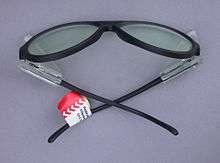
Safety glasses are worn to protect the eyes during a variety of tasks. They are made with shatter-resistant plastic lenses to protect the eye from flying debris and can shield the eyes from hazardous splatters such as blood or chemicals. There are also safety glasses for welding, which are styled like wraparound sunglasses, but with much darker lenses, for use in welding where a full sized welding helmet is inconvenient or uncomfortable. These are often called "flash goggles", because they provide protection from welding flash. Nylon frames are usually used for protection eyewear for sports because of their lightweight and flexible properties.
Sunglasses

Sunglasses provide improved comfort and protection against bright light and often against ultraviolet (UV) light. Photochromic lenses, which are photosensitive, darken when struck by UV light. The dark tint of the lenses in a pair of sunglasses blocks the transmission of light through the lens.
Light polarization is an added feature that can be applied to sunglass lenses. Polarization filters are positioned to remove horizontally polarized rays of light, which eliminates glare from horizontal surfaces (allowing wearers to see into water when reflected light would otherwise overwhelm the scene). Polarized sunglasses may present some difficulties for pilots since reflections from water and other structures often used to gauge altitude may be removed. Liquid crystal displays often emit polarized light making them sometimes difficult to view with polarized sunglasses.
Sunglasses may be worn just for aesthetic purposes, or simply to hide the eyes. Examples of sunglasses that were popular for these reasons include teashades and mirrorshades. Many blind people wear nearly opaque glasses to hide their eyes for cosmetic reasons.
Sunglasses may also have corrective lenses. Clip-on sunglasses or sunglass clips can be attached to another pair of glasses. Some wrap-around sunglasses are large enough to be worn over top of another pair of glasses. Otherwise, many people opt to wear contact lenses to correct their vision so that standard sunglasses can be used.
3D glasses
The illusion of three dimensions on a two dimensional surface can be created by providing each eye with different visual information. 3D glasses create the illusion of three dimensions by filtering a signal containing information for both eyes. The signal, often light reflected off a movie screen or emitted from an electronic display, is filtered so that each eye receives a slightly different image. The filters only work for the type of signal they were designed for.
Anaglyph 3D glasses have a different colored filter for each eye, typically red and blue or red and green. A polarized 3D system on the other hand uses polarized filters. Polarized 3D glasses allow for color 3D, while the red-blue lenses produce an image with distorted coloration. An active shutter 3D system uses electronic shutters. Head-mounted displays can filter the signal electronically and then transmit light directly into the viewers eyes.
Anaglyph and polarized glasses are distributed to audiences at 3D movies. Polarized and active shutter glasses are used with many home theaters. Head-mounted displays are used by a single person, but the input signal can be shared between multiple units.
Magnification (bioptics)
Glasses can also provide magnification that is useful for people with vision impairments or specific occupational demands. An example would be bioptics or bioptic telescopes which have small telescopes mounted on, in, or behind their regular lenses. Newer designs use smaller lightweight telescopes, which can be embedded into the corrective glass and improve aesthetic appearance (mini telescopic spectacles). They may take the form of self-contained glasses that resemble goggles or binoculars, or may be attached to existing glasses.
Yellow-tinted computer/Gaming glasses
A type of glasses, usually with a minor yellow tint. Basically performs minor color correction, on top of reducing headaches due to lack of blinking. May also be considered minor, corrective, unprescribed glasses.
Depending on the company, these computer or gaming glasses can also filter out high energy blue and ultra-violet light from LCD screens, fluorescent lighting, and other sources of light. This allows for reduced eye-strain. These glasses can be ordered as standard or prescription lenses that fit into standard optical frames.[3]
Due to the blue energy blocking nature of these lenses, they also help users sleep at night along with reducing age-related macular degeneration.[4]
Frames
The ophthalmic frame is the part of a pair of glasses which is designed to hold the lenses in proper position. Ophthalmic frames come in a variety of styles, sizes, materials, shapes, and colors.[5]
Parts
- two eye wires or rims surrounding and holding the lenses in place
- bridge which connects the two eye wires,
- chassis, the combination of the eye wires and the bridge
- top bar or brow bar, a bar just above the bridge providing structural support and/or style enhancement. The addition of a top bar makes a pair of glasses aviator eyeglasses
- brows or caps – plastic or metal caps which fit over the top of the eye wire for style enhancement and to provide additional support for the lenses. The addition of brows makes a pair of glasses Brow line glasses
- two nose pads that allow a comfortable resting of the eye wires on the nose
- two pad arms which connect the eye wire to the nose pads
- two end pieces which connect the eye wire via the "hinges" to the temples
- two hinges connecting the end pieces to the frames and allowing a swivel movement
- pair of frame-front end pieces
- two temples (earpieces) on either side of the skull
- two temple tips at the end of each temple
Temple types
- Spring-loaded flex hinge temples: These flex hinges are equipped with a small spring that affords the arms a greater range of movement and does not limit them to the traditional, 90 degree angle. Repairs can be made by using Self Aligning Spring Hinge Screws. Use screw insertion pliers to push the tip beyond the first barrel of a spring hinge at a 45 degree angle and use a standard screwdriver to tighten. As the screw moves down the barrel, it will move to a 90 degree angle. When finished, use a plier to break off the excess.[6]
- Skull temples: bend down behind the ears, follow the contour of the skull and rest evenly against the skull
- Library temples: generally straight and do not bend down behind the ears. Hold the glasses primarily through light pressure against the side of the skull
- Convertible temples: used either as library or skull temples depending on the bent
- Riding bow temples: curve around the ear and extend down to the level of the ear lobe. Used mostly on athletic, children’s, and industrial safety frames;
- Comfort cable temples: similar to the Riding bow but constructed from coiled, metal, flexible cable
Materials
Plastic
- Cellulose Acetate (Zyl)
- Optyl (A type of hypoallergenic material made especially for eyeglass frames. It features a type of elasticity that returns the material to its original shape)
- Cellulose propionate (molded, durable plastic)
- 3D-printed plastic using super-fine polyamide powder and Selective Laser Sintering processes – see Mykita Mylon (It should also be noted that the frames can be 3-D printed by fused filament fabrication for pennies of ABS, PLA or nylon)[7]
- Nylon
Metal
Natural materials
- Wood
- Bone
- Ivory
- Leather
- Semi-precious or precious stone
Corrective lens shape
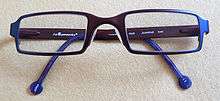
Corrective lenses can be produced in many different shapes from a circular lens called a lens blank. Lens blanks are cut to fit the shape of the frame that will hold them. Frame styles vary and fashion trends change over time, resulting in a multitude of lens shapes. For lower power lenses, there are few restrictions which allows for many trendy and fashionable shapes. Higher power lenses can cause distortion of peripheral vision and may become thick and heavy if a large lens shape is used. However, if the lens becomes too small, the field of view can be drastically reduced. Bifocal, trifocal, and progressive lenses generally require a taller lens shape to leave room for the different segments while preserving an adequate field of view through each segment. Frames with rounded edges are the most efficient for correcting myopic prescriptions, with perfectly round frames being the most efficient. Before the advent of eyeglasses as a fashion item, when frames were constructed with only functionality in mind, virtually all eyeglasses were either round, oval, or curved octagons. It was not until glasses began to be seen as an accessory that different shapes were introduced to be more aesthetically pleasing than functional.
History
Precursors


The use of a convex lens to form an enlarged/magnified image is discussed in Alhazen's Book of Optics (1021). Its translation into Latin from Arabic in the 12th century was instrumental to the invention of eyeglasses in 13th century Italy.[8]
Englishman Robert Grosseteste's treatise De iride ("On the Rainbow"), written between 1220 and 1235, mentions using optics to "read the smallest letters at incredible distances". A few years later in 1262, Roger Bacon is also known to have written on the magnifying properties of lenses.[9]
Sunglasses, in the form of flat panes of smoky quartz, were used in China during the 12th century.[lower-alpha 1] Similarly, the Inuit have used snow goggles for eye protection. While they did not offer any corrective benefits[11] they did improve visual acuity via the pinhole effect.
In India, an indigenous form of eyeglasses were thought to have been invented independently. Agrawal noted in the British Journal of Ophthalmology (1971) that:
The account of Devanarayan (between I344-I353), the use of spectacles by Vyasaraya (I520 A. D.), the indigenous manufacture of spectacle lenses in South India, the different terms used for spectacles in the North and South Indian languages, and other historical facts all indicate that spectacles were invented in India, in all probability by the Kannada speaking Hindus. It is therefore most likely that the use of lenses reached Europe via the Arabs, as did Hindu mathematics and the ophthalmological works of the ancient Hindu surgeon Susruta.[12]
Invention of eyeglasses
.jpg)
The first eyeglasses were made in Italy in about 1286, but it is not clear who the inventor was. In a sermon delivered on February 23, 1306, the Dominican friar Giordano da Pisa (ca. 1255–1311) wrote "It is not yet twenty years since there was found the art of making eyeglasses, which make for good vision... And it is so short a time that this new art, never before extant, was discovered. ... I saw the one who first discovered and practiced it, and I talked to him."[13] Giordano's colleague Friar Alessandro della Spina of Pisa (d. 1313) was soon making eyeglasses. The Ancient Chronicle of the Dominican Monastery of St. Catherine in Pisa records: "Eyeglasses, having first been made by someone else, who was unwilling to share them, he [Spina] made them and shared them with everyone with a cheerful and willing heart."[14] By 1301, there were guild regulations in Venice governing the sale of eyeglasses.[15]

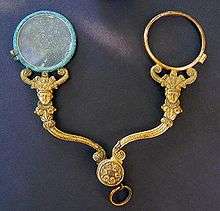
The earliest pictorial evidence for the use of eyeglasses is Tommaso da Modena's 1352 portrait of the cardinal Hugh de Provence reading in a scriptorium. Another early example would be a depiction of eyeglasses found north of the Alps in an altarpiece of the church of Bad Wildungen, Germany, in 1403.
These early glasses had convex lenses that could correct both hyperopia (farsightedness), and the presbyopia that commonly develops as a symptom of aging. It was not until 1604 that Johannes Kepler published the first correct explanation as to why convex and concave lenses could correct presbyopia and myopia.[lower-alpha 2]
Early frames for glasses consisted of two magnifying glasses riveted together by the handles so that they could grip the nose. These are referred to as "rivet spectacles". The earliest surviving examples were found under the floorboards at Kloster Wienhausen, a convent near Celle in Germany; they have been dated to circa 1400.[18]
Refuted claims
In 1907 Professor Berthold Laufer, a German-American anthropologist, stated in his history of glasses that "the opinion that spectacles originated in India is of the greatest probability and that spectacles must have been known in India earlier than in Europe".[19][20] However, Joseph Needham showed that the mention of glasses in the manuscript Laufer used to justify the prior invention of them in Asia did not exist in older versions of that manuscript, and the reference to them in later versions was added during the Ming dynasty.[21]
Although there have been claims that Salvino degli Armati of Florence invented eyeglasses, these claims have been exposed as hoaxes.[22][23] Furthermore, although there have been claims that Marco Polo encountered eyeglasses during his travels in China in the 13th century, no such statement appears in his accounts.[24][25] Indeed, the earliest mentions of eyeglasses in China occur in the 15th century and those Chinese sources state that eyeglasses were imported.[26]
Later developments


The American scientist Benjamin Franklin, who suffered from both myopia and presbyopia, invented bifocals. Serious historians have from time to time produced evidence to suggest that others may have preceded him in the invention; however, a correspondence between George Whatley and John Fenno, editor of The Gazette of the United States, suggested that Franklin had indeed invented bifocals, and perhaps 50 years earlier than had been originally thought.[27]
The first lenses for correcting astigmatism were designed by the British astronomer George Airy in 1825.[28]
Over time, the construction of frames for glasses also evolved. Early eyepieces were designed to be either held in place by hand or by exerting pressure on the nose (pince-nez). Girolamo Savonarola suggested that eyepieces could be held in place by a ribbon passed over the wearer's head, this in turn secured by the weight of a hat. The modern style of glasses, held by temples passing over the ears, was developed some time before 1727, possibly by the British optician Edward Scarlett. These designs were not immediately successful, however, and various styles with attached handles such as "scissors-glasses" and lorgnettes were also fashionable from the second half of the 18th century and into the early 19th century.
In the early 20th century, Moritz von Rohr and Zeiss (with the assistance of H. Boegehold and A. Sonnefeld[29]), developed the Zeiss Punktal spherical point-focus lenses that dominated the eyeglass lens field for many years.
In 2008, Joshua Silver designed eyewear with adjustable corrective glasses. They work by silicone liquid, a syringe, and a pressure mechanism.[30]
Despite the increasing popularity of contact lenses and laser corrective eye surgery, glasses remain very common, as their technology has improved. For instance, it is now possible to purchase frames made of special memory metal alloys that return to their correct shape after being bent. Other frames have spring-loaded hinges. Either of these designs offers dramatically better ability to withstand the stresses of daily wear and the occasional accident. Modern frames are also often made from strong, light-weight materials such as titanium alloys, which were not available in earlier times.
In fashion
In the 1930s, "spectacles" were described as "medical appliances."[31] Wearing spectacles was sometimes considered socially humiliating. In the 1970s, fashionable glasses started to become available through manufacturers, and the government also recognized the demand for stylized eyewear.[31]
Graham Pullin describes how devices for disability, like glasses, have traditionally been designed to camouflage against the skin and restore ability without being visible.[31] In the past, design for disability has "been less about projecting a positive image as about trying not to project an image at all."[31] Pullin uses the example of spectacles, traditionally categorized as a medical device for "patients", and outlines how they are now described as eyewear: a fashionable accessory.[31] Much like other fashion designs and accessories, eyewear is created by designers, has reputable labels, and comes in collections, by season and designer.[31] It is becoming more common for consumers purchase eyewear with clear, non-prescription lenses, illustrating that glasses are no longer a social stigma, but a fashionable accessory that "frames your face."[31]
Society and culture
Redistribution
Some organizations like Lions Clubs International,[32] Unite For Sight[33] and New Eyes for the Needy provide a way to donate glasses and sunglasses. Unite For Sight has redistributed more than 200,000 pairs.[34]
Fashion
.jpg)
Many people require glasses for the reasons listed above. There are many shapes, colors, and materials that can be used when designing frames and lenses that can be utilized in various combinations. Oftentimes, the selection of a frame is made based on how it will affect the appearance of the wearer. Some people with good natural eyesight like to wear eyeglasses as a style accessory.
Personal image
For most of their history, eyeglasses were seen as unfashionable, and carried several potentially negative connotations: wearing glasses caused individuals to be stigmatized and stereotyped as pious clergymen (as those in religious vocation were the most likely to be literate and therefore the most likely to need reading glasses), elderly, or physically weak and passive.[35][36] The stigma began to fall away in the early 1900s when the popular Theodore Roosevelt was regularly photographed wearing eyeglasses, and in the 1910s when popular comedian Harold Lloyd began wearing a pair of horn-rimmed glasses as the "Glasses" character in his films.[35][36]
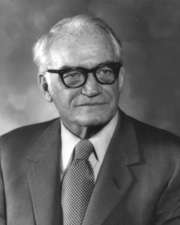
Since, eyeglasses have become an acceptable fashion item and often act as a key component in individuals' personal image. Musicians Buddy Holly and John Lennon became synonymous with the styles of eye-glasses they wore to the point that thick, black horn-rimmed glasses are often called "Buddy Holly glasses" and perfectly round metal eyeglass frames called "John Lennon (or Harry Potter) Glasses." British comedic actor Eric Sykes was known in the United Kingdom for wearing thick, square, horn-rimmed glasses, which were in fact a sophisticated hearing aid that alleviated his deafness by allowing him to "hear" vibrations.[37] Some celebrities have become so associated with their eyeglasses that they continued to wear them even after taking alternate measures against vision problems: United States Senator Barry Goldwater and comedian Drew Carey continued to wear non-prescription glasses after being fitted for contacts and getting laser eye surgery, respectively.
Other celebrities have used glasses to differentiate themselves from the characters they play, such as Anne Kirkbride, who wore oversized, 1980s-style round horn-rimmed glasses as Deirdre Barlow in the soap opera Coronation Street, and Masaharu Morimoto, who wears glasses to separate his professional persona as a chef from his stage persona as Iron Chef Japanese.
Recently, many NBA players wear lensless glasses with thick plastic frames like horn-rimmed glasses during post-game interviews, geek chic that draws comparisons to Steve Urkel.[38][39]
In superhero fiction, eyeglasses have become a standard component of various heroes' disguises (as masks), allowing them to adopt a nondescript demeanor when they are not in their superhero persona: Superman is well known for wearing 1950s style horn-rimmed glasses as Clark Kent, while Wonder Woman wears either round, Harold Lloyd style glasses or 1970s style bug-eye glasses as Diana Prince.
An example of the halo effect is seen in the stereotype that those who wear glasses are intelligent (See also Myopia#Education and IQ) or, especially in teen culture, even geeks and nerds. Some people who find that wearing glasses may look "nerdy" turn to contact lenses or laser eye surgery, especially under peer pressure. People wearing glasses are also often perceived as shy or quiet.
Styles
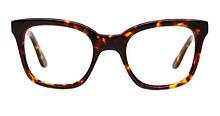
In the 20th century, eyeglasses came to be considered a component of fashion; as such, various different styles have come in and out of popularity. Most are still in regular use, albeit with varying degrees of frequency.
- Browline glasses
- Bug-eye glasses
- Cat eye glasses
- GI glasses
- Horn-rimmed glasses
- Lensless glasses
- Pince nez
- Rimless glasses
See also
Notes
- ↑ Chinese judges wore dark glasses to hide their facial expressions during court proceedings.[10]
- ↑ In his treatise Ad Vitellionem paralipomena [Emendations (or Supplement) to Witelo] (1604), Kepler explained how eyeglass lenses compensate for the distortions that are caused by presbyopia or myopia, so that the image is once again properly focused on the retina.[16][17]
References
- ↑ http://minnesota.cbslocal.com/2011/06/22/good-question-why-do-so-many-of-us-need-glasses/
- ↑ http://news.essilorusa.com/stories/detail/vision-impact-institute-releases-study-on-corrective-lens-wearers-in-the-u
- ↑ "BluTech Lenses – Technology, The story behind BluTech Lenses". BluTech Lenses.
- ↑ "Expert Healthy Vision & Eye Care Tips, News, Articles & Information – Essilor USA". essilorusa.com.
- ↑ "Optical Course". OpticalCourse.com. Retrieved 7 May 2014.
- ↑ Self Aligning Spring Hinge Screws | Vigor Optical, A division of Grobet USA | www.grobetusa.com
- ↑ Gwamuri, Jephias; Wittbrodt, Ben T.; Anzalone, Nick C.; Pearce, Joshua M. "Reversing the Trend of Large Scale and Centralization in Manufacturing: The Case of Distributed Manufacturing of Customizable 3-D-Printable Self-Adjustable Glasses". Challenges in Sustainability. 2 (1). doi:10.12924/cis2014.02010030.
- ↑ Kriss, Timothy C; Kriss, Vesna Martich (April 1998). "History of the Operating Microscope: From Magnifying Glass to Microneurosurgery". Neurosurgery. 42 (4): 899–907. doi:10.1097/00006123-199804000-00116. PMID 9574655.
- ↑ "...Optics Highlights: II. Spectacles". University of Maryland, Department of Electrical & Computer Engineering. Retrieved 2007-09-01.
- ↑ Needham 1962, p. 121.
- ↑ Ament, Phil (2006-12-04). "Sunglasses History – The Invention of Sunglasses". The Great Idea Finder. Vaunt Design Group. Retrieved 2007-06-28.
- ↑ http://bjo.bmj.com/content/55/2/128.full.pdf
- ↑ Ilardi 2007, p. 5.
- ↑ Ilardi 2007, p. 6.
- ↑ Ilardi 2007, p. 9.
- ↑ Ilardi 2007, p. 244.
- ↑ Ronchi, Vasco; Rosen, Edward (1991), Optics: The Science of Vision, Mineola, NY: Dover Publications, pp. 45–46
- ↑ "Rivet spectacles". www.college-optometrists.org. The College of Optometrists. 2015. Retrieved 28 February 2015.
- ↑ Laufer, Berthold (1907) "Geschichte der Brille" (History of eyeglasses), Mitteilungen zur Geschichte der Medizin und der Naturwissenschaften (Communications on the History of Medicine and the Sciences), 6 (4) : 379-385.
- ↑ Agarwal, R. K. (1971) "Origin of spectacles in India," British Journal of Ophthalmology, 55 (2) : 128-129. Available on-line at: National Center for Biotechnology Information
- ↑ "Science and Civilization in China Vol 4.1" (PDF). pp. 118–119. Retrieved May 3, 2014.
- ↑ Rosen, Edward (1956), "The invention of eyeglasses", Journal of the History of Medicine and Allied Sciences, 11: 13–46 (part 1), 183–218 (part 2), doi:10.1093/jhmas/xi.2.183
- ↑ Ilardi 2007, pp. 13-18.
- ↑ Needham 1962, p. 119, footnote c.
- ↑ Hirschberg, Julius (1911), "Geschichte der Augenheilkunde" [History of Ophthamology], in Graef, Alfred K; Saemisch, Theodor, Handbuch der gesamten Augenheilkunde [Handbook of all ophthalmology], 13, Leipzig, DE: Wilhelm Engelmann, p. 265
- ↑ Needham 1962, p. 119.
- ↑ "The 'Inventor' of Bifocals?". The College of Optometrists.
- ↑ Bruen, Robert. "Sir George Biddell Airy". The Lucasian Chair of Mathematics at Cambridge University. Robert Bruen. Retrieved 1 January 2014.
- ↑ "Eyeglass Lenses and Visual Aids from Industrial Production". Zeiss. Retrieved 2007-09-02.
- ↑ "Adspecs Eyeglasses Could Provide Sight for a Billion". TreeHugger.
- 1 2 3 4 5 6 7 Pullin, Graham; et al. (2009). "Fashion Meets Discretion". Design Meets Disability. Cambridge: MIT Press. pp. 13–64. ISBN 9780262162555.
- ↑ Lions Eyeglasses Recycling Facts, Lions Clubs International, retrieved 20 August 2008
- ↑ Donate Eyeglasses and Sunglasses, Unite For Sight, retrieved 20 August 2008
- ↑ "Brick Award Winner: Jennifer Staple", People: do something, HowStuffWorks, 20 February 2007, retrieved 20 August 2008
- 1 2 "Understanding Three-Piece Mounting", Eyewear, Seiko
- 1 2 Lloyd, Annette (1996), The Fashion of Harold Lloyd
- ↑ Sykes, Eric (2004-12-31), "Comedy Great", News, BBC
- ↑ "Whacky NBA Playoff Fashion!". YouTube. Google. Retrieved 2012-06-26.
- ↑ Cacciola, Scott (2012-06-14), "NBA Finals: LeBron James, Dwyane Wade and Other Fashion Plates of the NBA Make Specs of Themselves", The Wall Street Journal (oline ed.), retrieved 2012-06-26
Bibliography
- Ilardi, Vincent (2007), Renaissance Vision from Spectacles to Telescopes, Philadelphia, PA: American Philosophical Society.
- Needham, Joseph (1962), "part 1", Science & Civilisation in China, IV, Cambridge, ENG, UK: Cambridge University Press.
External links
 The dictionary definition of spectacles at Wiktionary
The dictionary definition of spectacles at Wiktionary-
 Media related to Glasses at Wikimedia Commons
Media related to Glasses at Wikimedia Commons -
 Quotations related to Glasses at Wikiquote
Quotations related to Glasses at Wikiquote - "Spectacles Gallery", Museum, British Optical Association.
- "Spectacles", The Medieval Technology, NYU.
- "Are Your Eyes Right", Popular Science (article), February 1944, on eyes and how eyeglasses correct vision (page 120).
- "Common Spectacles Styles before, during and after the Civil War", Archive.org (article), 2012, Antique Eyeglasses in America.